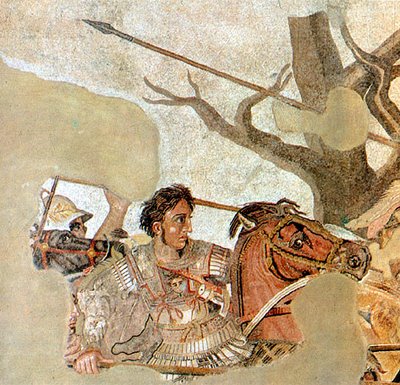Another Da Vinci Mystery?

Could this be an example of what a "Lost Leonardo" might look like now? Whatever did happen to "The Battle of Anghiari," a grimacing crunch of men and horses considered by some experts to be Leonardo's greatest painting? Well, it wasn't buried by Vesuvian flow as this one above was. This is the "Alexander Mosaic" from the House of the Faun, Pompeii, Italy. It is thought to be what is left Philoxenos of Eretria's "Battle of Issus, ca. 310 B.C.E. This is where Alexander humiliates Darius III, the Persian King in southern Turkey. It was a floor mosaic using tesserae (tiny stones and pieces of glass cut to desired size and shape instead of pebbles)
Scientist turned Art Detective, Maurizio Seracini is the only "real" person mentioned in "The Da Vinci Code". For 32 years he has chased a real mystery and he now seems ready to solve it. He has recently been given permission by the government of Italy to restart his search, which involves using the most modern detecting equipment to peer through a 500-year-old wall in the Palazzo Vecchio, Florence, Italy. On that wall, in 2002, he found a tantalizing crevice behind a Vasari Fresco. He believes that is where the "Lost Leonardo" may be sealed up.
The painting did exist, or at least a part of it depicting a fight for a standard on this particular wall in the former home of the Medicis, his frequent patrons. "Friday the 6th of June, 1505, at the stroke of the 13th hour," (1:P.M.)Leonardo wrote in one of his notebooks, (in his left-handed, mirror writing)"I started to paint in the palace." His younger rival, Michelangelo, had also been commissioned to paint his own battle scene on the opposite wall. He left for Rome and never even began it. Both men produced preparatory cartoons considered not only among the finest ever created but exemplary of the two strains of Renaissance Art the men embodied: Michelangelo drew heroic bathing nudes; Leonardo worked the motions and fury of men and horses in action. He was also marketing his talents as an inventor of "war machines" for the local combative Dukes. He studied war...among so many other things. He started much and finished little. Technical problems plagued him as he experimented with new processes for painting on plaster. i.e. "The Last Supper" not on wet plaster which is quicker but lasts longer but with oils on a wax-impregnated dry plaster. The condition of the hidden battle scene may be even worse than it predecessor, "The Alexander Mosaic". Then again, being sealed up in a wall away from the moister air of Florence, it may be in much better condition.
In the early 1970's, Seracini, a former medical student studying bioengineering in California, took an Art History course at UCLA from one of the leading Leonardo experts, an Italian professor, Carlo Pedretti. In 1975, Seracini returned to Florence, his hometown and again linked up with Pedretti who had begun to search for the "Lost Leonardo". It was then, on a scaffolding, that Seracini found a flag in the Varsari painting that he considered a possible sign of what might lay behind it: the words on the flag, "Cerca, trova," or "Seek and ye shall find." It turns out that that was the motto of one of the companies in the battle Leonardo had painted(?). From then on he developed a career using his engineering training and modern equipment to analyze works of Art. His most contentious finding, also landed him his unwelcome place in "The Da Vinci Code". In 2001, he proved that the paint in Leonardo's "Adoration of the Magi" was not applied by the master himself but much later by a "not very good artist".
The challenge is great. He cannot touch the Vasari, a treasure of its own, and instead must find a way to peer behind it with machines that do not exist yet. He has several theoretical methods, including a machine that would detect the pigments Leonardo used. There are records of the pigments, paid for by the city, of lead white, vermillion and a blue that might be lapis lazuli.
This is why I enjoy studying Art History. There are so many possibilities and causes for Art. I was inspired years ago by a display at the Claremont Colleges of "The Da Vinci Inventions". His drawings were superb and so exacting. He studied so many things and was a true "Renaissance Man". What an example for the ages. Bob!

0 Comments:
Post a Comment
<< Home